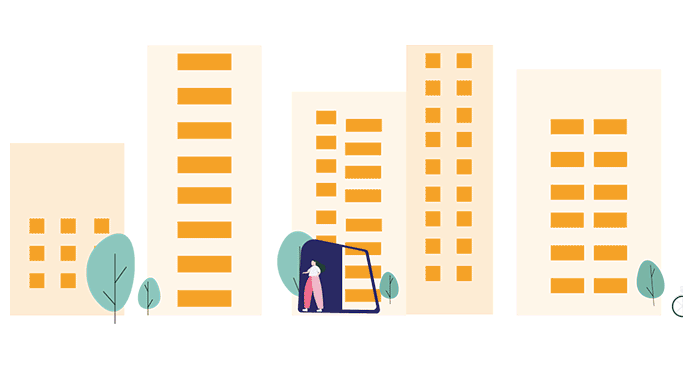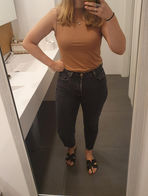
ReBe
Clothes sharing system
ReBe is my final project in the Department of Industrial Design at Bezalel academy of arts and design.
UX, UI, User Research, Prototyping, Branding, Industrial design
“I have nothing to wear" – who among us has never said that? We all love having a large selection of new clothes, but do we take into account the ecological and environmental price of the textile industry? ReBe is a clothes sharing system set up in the public space, where you can give clothes that are no longer in use and pick up new clothes. The system includes an app, a stand in the public sphere, and collaboration between people. With ReBe you can continue consuming clothes without harming the environment.
The Problem:
In the last few years, the world goes towards "fast fashion" that changes our consumption habits from end to end. We buy a lot more clothes and more frequently!
The fashion industry is one of the world's most polluting industries. It makes 10% of the world's greenhouse gas emissions, 20% of the world's freshwater consumption, and it is second largest freshwater polluter.
Every ten dollar t-shirt has an expensive ecological price tag.

Research:
The first question that comes to mind is what are the existing solutions to the problem of excessive clothes consumption?
-
Secondhand clothing shops where you can buy fashionable and vintage clothing.
-
Local initiatives such as giveaway benches, clothes swapping events, communal wardrobes, secondhand clothes sales in the local community, and others.
-
Fashion Companies some fashion companies provide secondhand, rental, and clothes recycling services at their premises or online.
But those options don't solve the problem. Most of the population doesn't buy secondhand clothes as those are perceived as lower quality. Clothes on street giveaway benches usually look dirty, unusable, and unappealing. And secondhand stores are quite old-fashioned and inaccessible, with piles of clothes that are hard to browse and find. Personally, I feel lost whenever I enter a secondhand store due to its messy look and feel.



Shared resource
Today there are incredible solutions to similar problems where resources are shared using a smart application. Just like what Airbnb did to housing, Scooter companies (like Lime) did to transportation, we would like to do clothing. So why can't we share clothes?
Survey
I conducted a survey of 185 people aged 20-65 understand the consumption habits of modern society. I learned that:
38%
do not wear almost 50% of their clothes.
51%
buy new clothes because they like having a variety of clothing options.
56%
wear new clothes because they like the feeling of buying something new.
60%
use shared services.
83%
don't consider the ecological price of new clothes.
70%
will wear "somebody's else's" clothes.
That made me realize that most people don't wear even half of their clothes, but still buy new clothes to get that feeling of buying something new. Moreover, most people don't even consider the ecological price of buying new clothes, even those who have ecological awareness.
Therefore, there is a need for a clothes sharing system, that will rely on secondhand clothes but will still give you that "brand new" feeling. And mostly, will be convenient and accessible.

The Solution:
ReBe is a clothes-sharing system that works in the community, in neighborhoods, or in buildings, and it enables the user to give away clothes that are no longer in use and to purchase new secondhand clothes.
ReBe is based on the participation of the community and the quantity and quality of the clothes shared. ReBe is comprised of an app and sharing stations located in the community.
The clothes in ReBe are regularly checked to guarantee the quality of clothes offered on the system, and the users are responsible to report damaged clothes and uploading the correct details of clothing.
Clothes can be purchased or rented by money, or be ReBe credit that can be acquired by giving away clothes on the system.
ReBe use scenario:
There are two ways of using ReBe, order clothes or give away clothes.
The app is fully synced with the ReBe stations and are co-dependent.

Buy or Rent? Sometimes we look for clothes for an event and there is no need to buy new clothes when you can rent them. Also, sometimes we buy new clothes but never actually wear them. How great would it be if we could rent clothes before buying them? In Rebe, clothes can be either bought or rented. Renting clothes enables the user to check clothes before buying them, so when the rental period ends the user must return it to a ReBe station, or fully purchase the product.
The app:


Home Screen

Shows the new items added to the current home screen. The home station can be changed.
Review give away requests
Review orders requests
Order Clothes

The ReBe app shows the available clothes at all stations, viewed by stations and then by clothing category.
Clothes can be filtered by sizes, colors, prices and other filters.
The item screen shows the item details, purchase date, item condition, and pictures of past users wearing it.


Filter

Sort by...

Change Station

Item Details

Order Clothes
Go to station for pick up
To pick up the order, go to the home screen and scan the item's barcode on the station scanner. The station ejects the item box.




Order Clothes
Return
After 30 days of rental the user must decide if to purchase the item, or to return it to the station. Prior to item return, the user needs to fill a form to report new defects and upload a current picture while wearing it. The form is validated to ensure the quality of the item. Upon confirmation the user can approach the station and scan the barcode with the station scanner. An empty box is ejected, and the user folds the item to it.
Review the order on the home screen
Fill the form and upload a picture
Barcode
Folding instructions




Give away clothes

On give away requests the user registers the new item including the purchase date, condition, and defects. Two pictures need to be uploaded, item on a white background, and while wearing the item. The requests proceeds to confirmation. The order remains on the home screen until confirmation, then the user receives a barcode to scan at the station.

The clothes are stored and folded in transparent boxes that you can see from the display window. The station contains a touch screen that shows the clothes available inside, and a slot where the boxes are inserted and ejected. Hanging hooks and carry-on bags are located near the slot.
The station is narrow by design to minimize space occupation, the base depth is 80 cm, ceiling depth is 101 cm. The station's height is 2.3 meters and 2.5 meters wide.
The stations were thoroughly designed as an industrial design project, including manufacturing instructions.
The Station:
How It Works
The Boxes
There are 3 types of boxes, all the same length so they fit in the station uniformly. The boxes are transparent so the folded clothes will be seen from the display window. To ensure the uniform folding of clothes, the folding instructions are printed on the wall of the station, and are present on the app.
.jpg)


Socialization and Body Image Influence:
ReBe offers a community based, ecological friendly clothing service, but also enables the community to interact with each other by recommending clothes on the app. Also, it is an opportunity for people with low self-esteem to view clothes on regular sized people instead of models.

Pricing Method:
Example:
T-Shirt
Original price: 90 NIS
Condition: used
Purchase date: two years ago
ReBe evaluation: 22.5 NIS
Giver Credit: 20.25
Rental price: 11.25 NIS per month
Purchase Price: 22.5 NIS
1
The price of an item is based on its original price, purchase date and condition.
2
The giver of the item receives 90% of its value as credit.
3
Rental and purchase prices are fixed according to the evaluation.
More Discussion Points:
The final project addressed more topics that were not mentioned here, such as:
-
Business Model
-
More details regarding the process: laundry, deterioration, measuring.
-
Stations' manufacturing instructions including materials.




